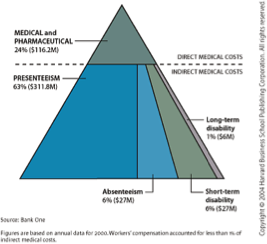Integrative medicine and the conditions with highest productivity costs for employers
February 22, 2017
 A little-known factoid that could be a game-changer in thinking about integrative health and medicine strategies is that the most expensive cost of poor health to employers is not the cost of medical services, or absenteeism, or ability, or the cost of replacing workers. Rather, it is something that researchers over the past 15-20 years have begun measuring as “presenteeism.” Presenteeism is basically a productivity measure. Researchers estimate that this measure accounts for a whopping 50 percent to 63 percent of the global costs of health to employers. Medical services, direct and indirect, and account for just 24 percent.
A little-known factoid that could be a game-changer in thinking about integrative health and medicine strategies is that the most expensive cost of poor health to employers is not the cost of medical services, or absenteeism, or ability, or the cost of replacing workers. Rather, it is something that researchers over the past 15-20 years have begun measuring as “presenteeism.” Presenteeism is basically a productivity measure. Researchers estimate that this measure accounts for a whopping 50 percent to 63 percent of the global costs of health to employers. Medical services, direct and indirect, and account for just 24 percent.  I recently stumbled upon a piechart that brought to mind a strategic question: Might lowering presenteeism for employers represent the most significant major stakeholder partnership for integrative practices? The chart, from the consulting firm KPMG Econtech, demonstrates the “Contribution of medical conditions to overall productivity loss.” The productivity losses show up on the employer’s ledgers multiple ways. Pain conditions can lead to sleeplessness and distract from focus. Medications utilized to control pain, allergies, and multiple others of these conditions similarly influence focus, suggesting an additional value for non-pharmacologic approaches. Irritability rubs off on co-workers, stirring its own nest of water-cooler chatter and productivity barriers. Doctor visits need to be managed. Half-days can be quickly lost. Bad attitudes are catching. Dollars disappear with each level of poor concentration. Most broad-scope integrative practitioners will find themselves swimmingly at home with many of the types of symptoms and conditions highlighted here. Allergy. Depression. Back, neck or spinal problems. Headaches. Hypertension. Together these account for 70 percent of productivity loss. Find ways to better the quality of life of people with diabetes, heart disease, cancer, arthritis and respiratory disorders and the whole pie is an area of potentially productive influence. Comment: These rough facts suggest a good deal of alignment between employers and integrative practices on saving huge dollars for employers. I first considered this potential under the tutelage of Sean Sullivan, JD, the Harvard-educated founder of the Institute for Health and Productivity Management.
I recently stumbled upon a piechart that brought to mind a strategic question: Might lowering presenteeism for employers represent the most significant major stakeholder partnership for integrative practices? The chart, from the consulting firm KPMG Econtech, demonstrates the “Contribution of medical conditions to overall productivity loss.” The productivity losses show up on the employer’s ledgers multiple ways. Pain conditions can lead to sleeplessness and distract from focus. Medications utilized to control pain, allergies, and multiple others of these conditions similarly influence focus, suggesting an additional value for non-pharmacologic approaches. Irritability rubs off on co-workers, stirring its own nest of water-cooler chatter and productivity barriers. Doctor visits need to be managed. Half-days can be quickly lost. Bad attitudes are catching. Dollars disappear with each level of poor concentration. Most broad-scope integrative practitioners will find themselves swimmingly at home with many of the types of symptoms and conditions highlighted here. Allergy. Depression. Back, neck or spinal problems. Headaches. Hypertension. Together these account for 70 percent of productivity loss. Find ways to better the quality of life of people with diabetes, heart disease, cancer, arthritis and respiratory disorders and the whole pie is an area of potentially productive influence. Comment: These rough facts suggest a good deal of alignment between employers and integrative practices on saving huge dollars for employers. I first considered this potential under the tutelage of Sean Sullivan, JD, the Harvard-educated founder of the Institute for Health and Productivity Management.  Sullivan and I were on a phone call discussing the perverse incentives in medicine relative to the uptake of integrative care. He made a crucial and enduring distinction. You are looking at integration from the “supply side,” he told me. Both hospitals and insurers are suppliers of services. In their distinct ways, these two stakeholders have done quite well in the steady rise to $3 trillion in healthcare income annually that characterizes U.S. medicine. Perhaps, Sullivan then suggested, you might be better off seeking integration from the “demand side.” These are the purchasers of healthcare services: employers, government agencies, and consumers. These stakeholders benefit from health, rather than disease. These are the interests for whom the $3 trillion registers as cost rather than as income. (As described here, the insurer’s incentives, while mixed, are squarely on the supply side.)
Sullivan and I were on a phone call discussing the perverse incentives in medicine relative to the uptake of integrative care. He made a crucial and enduring distinction. You are looking at integration from the “supply side,” he told me. Both hospitals and insurers are suppliers of services. In their distinct ways, these two stakeholders have done quite well in the steady rise to $3 trillion in healthcare income annually that characterizes U.S. medicine. Perhaps, Sullivan then suggested, you might be better off seeking integration from the “demand side.” These are the purchasers of healthcare services: employers, government agencies, and consumers. These stakeholders benefit from health, rather than disease. These are the interests for whom the $3 trillion registers as cost rather than as income. (As described here, the insurer’s incentives, while mixed, are squarely on the supply side.)  This separation of the firmaments is profoundly useful, though rarely acted upon. One example was a cardiovascular risk trial headed by Dugald Seely, ND from Canadian College of Naturopathic Medicine and economist Patricia Herman, ND, PhD with the RAND Corporation. The inclusion of presenteeism as a measure showed the naturopathic care of Canadian postal workers to be cost effective. For the most part, the direct evidence of integrative programs for employer presenteeism a rare measure in integrative trials. For the most part, employers work through their employee benefits managers and their selected insurers. The insurers contract, in turn, with certain medical delivery organizations. Some of these may have integrative health and medicine programs. Thus, getting an employer to examine the potential value in an integrative health partner means vaulting across these oceans of organizational self-interest. Of course, given the at best impressionistic data, even considering the value integrative care may have in reducing presenteeism—no matter how robust the apparent possibility - requires an employer champion to begin this journey across the great waters via a leap of faith.
This separation of the firmaments is profoundly useful, though rarely acted upon. One example was a cardiovascular risk trial headed by Dugald Seely, ND from Canadian College of Naturopathic Medicine and economist Patricia Herman, ND, PhD with the RAND Corporation. The inclusion of presenteeism as a measure showed the naturopathic care of Canadian postal workers to be cost effective. For the most part, the direct evidence of integrative programs for employer presenteeism a rare measure in integrative trials. For the most part, employers work through their employee benefits managers and their selected insurers. The insurers contract, in turn, with certain medical delivery organizations. Some of these may have integrative health and medicine programs. Thus, getting an employer to examine the potential value in an integrative health partner means vaulting across these oceans of organizational self-interest. Of course, given the at best impressionistic data, even considering the value integrative care may have in reducing presenteeism—no matter how robust the apparent possibility - requires an employer champion to begin this journey across the great waters via a leap of faith. 




















SHARE